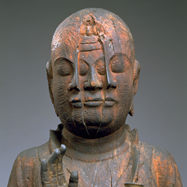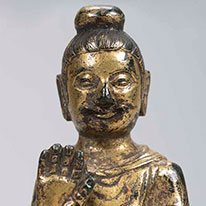Past Exhibitions
- Japanese Sculpture
- December 18, 2018 - March 17, 2019
What do Japanese sculptures depict? Before the Edo period, almost all Japanese statues were of deities or religious figures. Buddhist sculptures have been produced in Japan since Buddhism came to the archipelago in the seventh century. Japanese Buddhist deities often have origins in South Asia and the Himalayas. These were usually imported into Japan by way of China, bringing foreign influences with them.
One of the distinctive characteristics of Japanese sculpture is its use of wood as a primary material. Various modes of carving and other techniques—including joint-block construction (yosegi-zukuri) and inlaid crystal eyes—were developed in Japan to create these wood images.
The Japanese Buddhist sculptures on view here come from different historical periods. Their varied styles exemplify the repeated waves of influence from the Asian mainland as well as subsequent Japanese innovations.
- Chinese Buddhist Sculpture
- December 18, 2018 - March 17, 2019
This small-scale exhibition features Buddha sculptures made in China between the Sixteen Kingdoms period (fourth century) and the Yuan or Ming dynasty (fifteenth century). Made from a variety of materials including wood, bronze, earthenware, and stone (not a common sculptural medium in Japan), these statues represent Buddhist deities such as buddhas, bodhisattvas, and devas, and include two unusual sculptures of monks. As you enjoy these images, you might also take this opportunity to compare them to the Japanese Buddhist sculptures on view in this gallery. What makes them different?













